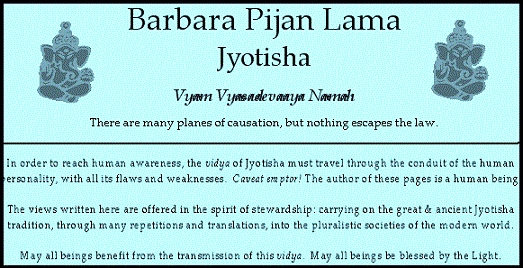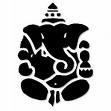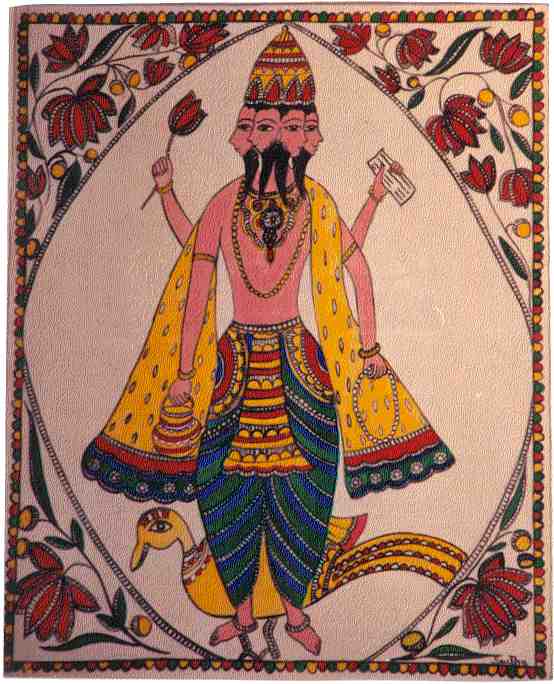
2 x 30
3 x 20
4 x 15
5 x 12
6 x 10
micro-results of the 12th-angle
Fine-Tuning of Rectification results
see also disambiguation: shastiamsha table of 1800 portions

-
D-3 Dreshkamsha = [drekkana]
-
D-24 Siddhamsha = [Chatur-vimsh-amsha]
-
D-40 Khavedamsha = [Chat-varimsh-amsha]

षष्ट्यन्श ṣaṣṭyanśa
Shashtyamsha
षष्टि ṣaṣṭi = sixty
कला kalā = time = name for sixty
षष्टिक अंश ṣaṣṭikamśa
= sixtieth portion, sixtieth division
1/60 portion
1/60 of a rashi
= 00-deg-00-min-30-sec
Sixtieth Divisional Chart
D-60
Shastyans - Shastiamsam
dasha-varga

Four-Headed Brahma
Caveat Emptor
Accuracy of divisional charts depends entirely on accuracy of birth time
Varga charts can supply a useful adjunct perspective upon the significations of the graha.
However, if accurate birth time is not available, divisional charts are misleading, and should be ignored.
disambiguation
: D-60 varga = distinguishable from the Shastiamsha table of 60 portions within one 30-degree rashiQUOTATION
BPHS Sarga 6, shloka-33-41
Shashtiamsha = 1/60th of a Rashi = half-degree for each amsha
amsha = portion
These are the BPHS (recompiled) designations. See Shastyamsha 1899 portions chart.
Phala-deepika gives a different list.
[begin quote]
" To calculate the Shashtiamsha Lord
-
ignore the Rashi position of a Graha
-
and take the degrees etc. it traversed in that Rashi.
-
Multiply that figure by 2 and divide the degrees by 12.
-
Add 1 to the remainder,
-
which will indicate the Rashi, in which the Shashtiamsha falls.
-
The Lord of that Rashi is the Graha, ruling the said Shashtiamsha.
In odd Rashi, the names of Shashtiamsha are:
1. Ghora
2. Rakshasa
3. Deva
4. Kubera
5. Yaksha
6. Kindara
7. Bhrashta
8. Kulaghna
9. Garala
10. Vahni
11. Maya
12. Purishaka
13. Apampathi
14. Marutwana
15. Kaala
16. Sarpa
17. Amrit
18. Indu
19. Mridu
20. Komala
21. Heramba
22. Brahma
23. Vishnu
24. Maheshwara
25. Deva
26. Ardra
27. Kalinasa
28. Kshiteesa
29. Kamalakara
30. Gulika
31. Mrityu
32. Kaala
33. Davagni
34. Ghora
35. Yama
36. Kantaka
37. Suddha
38. Amrita
39. PurnaChandra
40. Vishadagdha
41. Kulanasa
42. Vamshakshaya
43. Utpata
44. Kaala
45. Saumya
46. Komala
47. Sheetala
48. Karaladamshtra
49. Candramukhi
50. Praveena
51. Kaalpavaka '
52. Dhannayudha
53. Nirmala
54. Saumya
55. Krura
56. Atisheetala
57. Amrita
58. Payodhi
59. Brahmana
60. Chandra-Rekha (InduRekha).
The reverse is the order for even Rashi
- in so much, as these names are used.
Graha in benefic Shashtiamsha produce auspicious,
while the opposite is true in case of Graha in malefic Shashtiamsha."
D-60 Shashtyamsha = 60 is a cycle-completer.
Patterns of 6 + 10 offer a glimpse into the structure of incarnational learning.
6-10 hold a relative 5-9 angle.
It is a definitive and auspicious pair of patterns can show at an esoteric level, where the spirit /jumps in/ to the cycle, similar to the way a skillful single dancer would jump into a group of dancers in motion.
Timing is everything.
60 is a full cycle in the earth-pulse base-12 system.
Patterns of 5 + 12 are also here.
Functionally, ashasty-amsha difference helps to distinguish twins.
Microview of 12th angle = closure, completion, maximum predicted performance of each graha
Field of Psychic Expectation for Specific Matters of Total Life Destiny
Generally, the Shasty-amsha = 60th division = produces an overview of the capacity of each individual graha. All of the graha are important to assess in D-60.
The Shastyamsha Varga provides a microscope detail of the 12th-angle and its implications of closure, finality, dissolution of material form, erosion of identity, and the laste experiences before embarking upon the bridge to the astral plane.
Within the D-60, confirm the disposition of
- the radical vyaya-pati (conclusions, disappearance, immaterial actions such as meditation, psycho-spiritual guidance, astral awareness)
- the ātmakāraka (ultimate dispositions)
- the ruler of 12th-from-Chandra (emotional completion).
D-60 provides an efficient view of range of behavior of the karaka in the current terrestrial lifetime.
Graha behavior in D-60 may indicate the " dream state" of each graha, showing its behavior when the Learner is busy in astral worlds during sleep.
For example if Shukra is highly dignified in D-60, the Learner may have deeply enjoyable aesthetic harmonious experiences in the sleep state, even if relationships in the waking material state are less balanced.
For matters of career (10, 7) or schooling (4, 7) or marriage (7, 12) seek the disposition of the D-1 rulers within their Shastyamsha.
For example if the karmesha suffers a nichhamsha condition in the D-60, there are likely some low qualities of the leadership behaviors in social reality which signify limits on one's rise into high visibility roles.
~~ BPHS Sarga-7, shloka-8
" The bhava whose lord is in a malefic Shashtyamsha will diminish, so say Garga and others."
Traditional time measurement units
en.wiktionary.org/wiki/Appendix:Hindu_units_of_measurement
-
One Shasthyamsha = 30 minutes of Arc.
-
720 Shasthyamsa = the full 360-degree circle .
-
Shasthyamsha lords are either malefic or benefic.
Each of the varga can aid verification of the birth time. One important predictor can be the presence of ātmakāraka in the D-60 shastyamsha lagna. ātmakāraka (found in both Parashari and Jaimini traditions) is the graha which holds the highest degree among the seven classical graha.
If the nativity shows a promise of social distinction , note the characteristics of the ātmakāraka -graha residing in the D-60 shastyamsha lagna to find a keynote of one's life narrative and contribution to society.
-
POTUS-29 Teapot Dome 1865-1923 Warren G. Harding had Mangala-yuti-Rahu in Mesha indriya-lagna of D-60. Harding's life was lived with sexual intensity and masculine competitive pursuit. He maintained multiple lovers and behaved in extraordinary ways.
Soothing protective Chandra is an enemy of Professor Budha, an dBantering Budha activates his radical Jyeṣṭha lagna.
Harding had brief careers in teaching and sales [Budha] before becoming a newspaperman [Budha] . His speech style was roguish and very plebian.
Notoriouslym he fabricated his own words, which seemed intuitively right to him [Chandra] . He was the laughing stock of the educated urban classes . Yet, similar to POTUS-43 Decision Points 1946- George W. Bush his chronic malapropisms (Budha + Shani) gave him an aura of rural credibility among the working folk [Chandra] .
Evaluating retrograde graha
One use of D-60 is to determine whether a retrograde planet will give fruits or not.
Retrograde planet results are normally delayed, but not denied.
-
Some schools of thought assert that a retrograde malefic gains power, while a retrograde benefic loses power. There is some merit to the different opinions on the true effects of retrograde.
-
The Shashtyamsha lord help make the determination of good or difficult results because the Shashtyamsha lord will either be malefic or benefic, and this may help to settle the case.
If the graha falls into a malefic Shashtyamsha , it is considered that negative Akashic memory patterning is operating there is a need for payback.
In the case of negative Shashtyamsha position it becomes more likely that results of the graha will be delayed or denied denied.
D-60 can reveal unpaid debt from parallel lives which affects the social dignity in the current life
Humiliation? Respect? Humble station or high ? Use or misuse of social-regulatory power.
One utility of D-60 is to determine whether a retrograde* vakri graja will give fruits or not. Retrograde usually causes delayed results, but not denied results.
However, if there is significant pre-incarnationally planned requirement for payback through the retrograde planet, then it becomes more likely that results are truly denied.
D-60 may reveal the downside of an otherwise excellent-looking radix graha.
Nakshatra identified withi the Shastiamsha Lagna can reveal fine distinctions of life purpose = pre-incarnationally planned underbelly of apparently magnificent D-1 graha
It is common to see the exalted planets of morally corrupt political dictators and apparently successful thieves, as being quite devastated in the shastyamsha.
-
This situation indicates that a temporarily powerful person may endure a tragic fall from power during the period of the D-1's uttama graha which occupies nīcha-amsha in the D-60.
-
Jyotiṣika check the D-60 to correct their spot judgment regarding especially magnificent planets.
-
If that exalted Guru in dharma svabhava seems intuitively too good to be true, it probably is.
-
Destiny-defining graha = typically located in the indriya-lagna of the D-60.
-
Placement of ātmakāraka or D-1 lagnesha within D-60 lagna = great aid in rectification
-
The D-60 can reveal the pre-incarnationally planned under-belly if there is one.

[How Readings Work] = [Sample Sacred Jewels Ratna Recommendation] = [Seva]
 file update =
15-Jan-2026
file update =
15-Jan-2026
[Copyright 1994-2094 by Barbara Pijan Lama] = [Contact] = [How to Request a Jyotishavidya Reading]
Barbara Pijan Lama Jyotishavidya Vedic Astrology Surya Sun Chandra Moon Mangala Mars Budha Mercury Guru Jupiter Shukra Venus Shani Saturn Rahu Ketu Graha Planets Dasha Timeline Calendar Nakshatra Navamsha Marriage Children Treasury Career Spiritual Wisdom Cycles of re-Death and re-Birth
The information on barbarapijan.com , including all readings and reports, is provided for educational purposes only. Wishing you every happiness and continuing success in studies!
